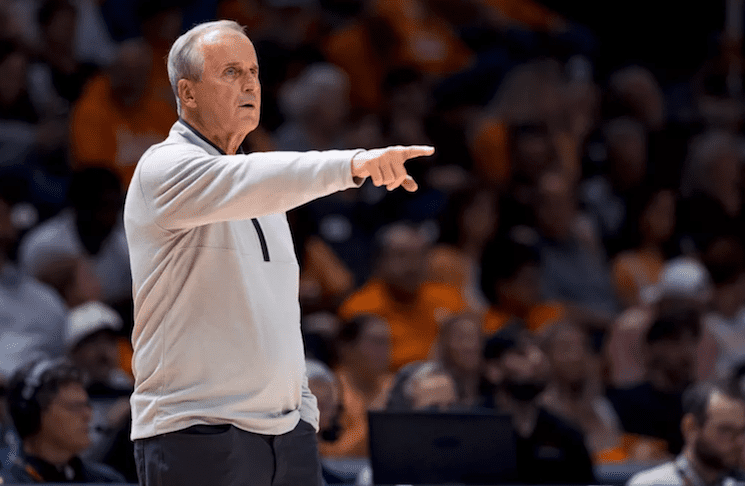
When someone asks about the top quarterbacks in the SEC, Tennessee’s Jarrett Guarantano doesn’t immediately spring to mind. But maybe he should if one of ESPN’s more prominent college football analysts is to be believed.
Bill Connelly used to run things for SB Nation and gained a lot of clout for his analysis there. Now, he works for ESPN as one of their main digital content creators. Connelly delves into stats and is big on analytics, and he’s the creator of the S&P+ model of statistics for college football.
And he’s a big believer in Jarrett Guarantano.
In a piece looking at 10 of the craziest stats from the 2018 season and what it tells him about the 2019 season, he analyzed Guarantano’s numbers from his redshirt sophomore season. Earlier this month, a fellow ESPN writer, David Hale, called Guarantano the most likely “under-the-radar player” in college football to be a breakout star in 2019. Hale compared Guarantano’s efficiency and his overall numbers to Oregon’s Justin Herbert. Herbert is considered one of the top quarterbacks in the country heading into the 2019 season, but Guarantano actually put up better numbers from an efficiency perspective.
Tennessee’s starting quarterback last season had a better completion percentage (62.2% to 59.4%), third down conversion percentage (41% to 35%), and a better TD to INT ratio (4-1 to 3.4-1) than Herbert despite Herbert getting more acclaim. Both quarterbacks had the same yards per attempt at 7.8 yards per pass.
According to Connelly, Guarantano did all that even with one of the worst offensive lines and rushing attacks in college football last season.
“Guarantano pulled off Herbert-esque numbers despite living life with one of the worst run games imaginable,” Connelly writes. “Not even including sacks, 32.6% of Tennessee’s rushes were stuffed at or behind the line, worst in FBS. Only 41% of the carries gained at least 4 yards (119th). The Vols ran the ball constantly (and predictably) on early downs — their run rate was 64% on standard downs, nearly 5 percentage points higher than the national average — and all it produced were lots of second-and-11s and heavy pass rushes when Guarantano was looking to make up ground.”

To Connelly’s point, Tennessee’s offense last season under offensive coordinator Tyson Helton was skewed heavily towards the run, especially on first down.
According to CFBStats.com, Tennessee ran 314 plays on first down last season. Of those 314 plays, only 95 of them were pass attempts. The Vols ran the ball 219 times on first down, comprising 69.8 percent of their first down plays.
Guarantano himself only threw the ball 80 times on first down, going 47-of-80 (58.8 percent) for 662 yards, four touchdowns, and one interception.
On second down, however, Guarantano was at his best.
Despite often facing second-and-long situations due to Tennessee’s inefficient run game, Guarantano completed 64.1 percent of his 78 pass attempts on second down, throwing for 620 yards, five touchdowns, and zero interceptions.
On third down, Guarantano was similarly efficient, especially in third-and-medium range. When facing third down and between 4-9 yards to go, Guarantano completed 34 of his 44 pass attempts (77.3 percent) for 344 yards and a touchdown with no interceptions. He helped the offense pick up a first down on 24 of his 33 completions in those situations.
If Guarantano can get more protection himself (Guarantano faced pressure on 8.2% of his dropbacks last season, 106th in the FBS), Connelly thinks he can truly excel. And Connelly also believes new offensive coordinator Jim Chaney will be a big asset for Guarantano.
“New offensive coordinator Jim Chaney is one of the better coaches in America when it comes to crafting a system around the standout talent he has at his disposal,” Connelly states. “Sometimes that means a run-heavy approach, and sometimes it means a lot of passing. With Guarantano and almost his entire receiving corps back (including a hell of a wideout trio in Marquez Callaway, Jauan Jennings and Josh Palmer), I’m guessing Chaney leans toward the latter.”
At Georgia, Chaney’s offenses tended to be more run-heavy because that was the strength of the Bulldogs’ roster. In his three years at Georgia, the Bulldogs ran the ball 1,770 times compared to 1,057 pass attempts in that same span. On the flip side, Tennessee threw the ball 477 times compared to 413 rushing attempts in 2012 when Chaney was the OC. In fact, with the exception of his first year as UT’s offensive coordinator in 2009, Chaney’s offenses always had more passing attempts than rushing attempts during his first stint in Knoxville.
With a veteran group of wide receivers, a physically gifted tight end in Dominick Wood-Anderson, and solid pass catching options out of the backfield at running back, Jarrett Guarantano has all the tools at his disposal to have success in 2019. He just needs help from his offensive line and running game.



